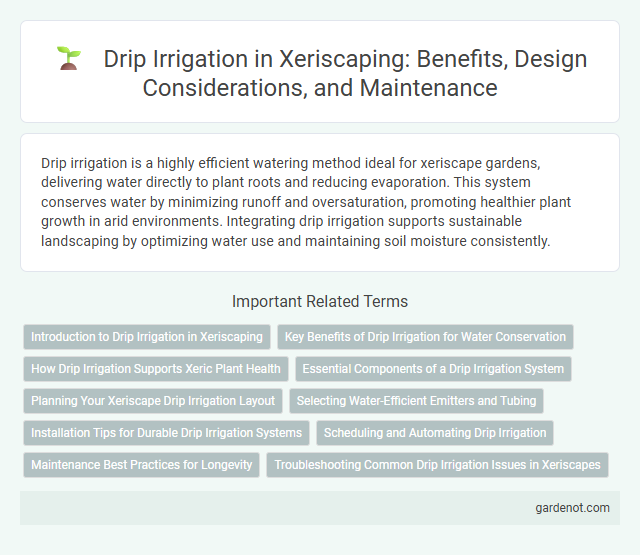Drip irrigation is a highly efficient watering method ideal for xeriscape gardens, delivering water directly to plant roots and reducing evaporation. This system conserves water by minimizing runoff and oversaturation, promoting healthier plant growth in arid environments. Integrating drip irrigation supports sustainable landscaping by optimizing water use and maintaining soil moisture consistently.
Introduction to Drip Irrigation in Xeriscaping
Drip irrigation delivers water directly to plant roots through a network of tubes, emitters, and valves, maximizing efficiency in xeriscaping by minimizing evaporation and runoff. This targeted watering system supports drought-tolerant landscapes by providing precise moisture levels, promoting healthy plant growth with reduced water waste. Implementing drip irrigation in xeriscape gardens conserves significant water resources while maintaining optimal soil hydration for native and xerophytic plants.
Key Benefits of Drip Irrigation for Water Conservation
Drip irrigation delivers water directly to plant roots, minimizing evaporation and runoff, which significantly conserves water compared to traditional irrigation methods. This targeted watering system reduces water waste by up to 50%, making it ideal for xeriscaping and drought-prone areas. Efficient moisture management also promotes healthier plant growth and lowers overall water bills.
How Drip Irrigation Supports Xeric Plant Health
Drip irrigation delivers water directly to the root zone of xeric plants, minimizing evaporation and runoff, which is essential for conserving water in xeriscape gardening. This targeted watering method maintains optimal soil moisture levels, promoting deep root growth and enhancing plant resilience in arid environments. Efficient water use through drip irrigation reduces stress on drought-tolerant species, supporting sustainable xeric plant health and landscape longevity.
Essential Components of a Drip Irrigation System
A drip irrigation system essential components include drip emitters, tubing, filters, and pressure regulators, ensuring precise water delivery to plant roots while minimizing waste. Emitters control water flow rates, while tubing distributes water throughout the landscape, typically made from durable polyethylene. Filters prevent clogging by removing debris, and pressure regulators maintain consistent water pressure to optimize system efficiency and water conservation in xeriscape gardens.
Planning Your Xeriscape Drip Irrigation Layout
Planning your xeriscape drip irrigation layout involves mapping plant zones based on water needs and grouping drought-tolerant species together for efficient watering. Designing separate drip lines for different plant types minimizes water waste while ensuring optimal moisture levels. Incorporate pressure regulators and filters to maintain consistent flow and prevent clogging in the xeriscape irrigation system.
Selecting Water-Efficient Emitters and Tubing
Selecting water-efficient emitters and tubing is crucial for effective drip irrigation in xeriscape landscaping. Pressure-compensating emitters ensure uniform water distribution across varied terrain, minimizing runoff and maximizing moisture retention in arid environments. Utilizing UV-resistant polyethylene tubing enhances durability and maintains consistent water flow, optimizing irrigation efficiency in drought-prone regions.
Installation Tips for Durable Drip Irrigation Systems
Installing a durable drip irrigation system requires selecting high-quality polyethylene tubing resistant to UV rays and wear for long-lasting performance. Properly spacing emitters according to plant water needs and soil type ensures efficient water delivery and prevents system clogging. Regularly flushing the system and using filter screens maintain optimal flow and extend the lifespan of the drip irrigation setup in xeriscape landscaping.
Scheduling and Automating Drip Irrigation
Scheduling and automating drip irrigation ensures plants receive precise water amounts at optimal times, reducing water waste and promoting healthy growth. Smart controllers and soil moisture sensors enable customized irrigation schedules that adapt to weather conditions and soil moisture levels. Automation enhances efficiency by delivering water directly to the root zone, minimizing evaporation and runoff in xeriscape landscapes.
Maintenance Best Practices for Longevity
Drip irrigation in xeriscape landscapes requires regular inspection of emitters to prevent clogging and ensure uniform water distribution. Flushing the system periodically removes sediment and mineral buildup, enhancing efficiency and system lifespan. Protecting tubing from UV damage and mechanical wear, combined with seasonal adjustments based on plant water needs, maximizes longevity and conserves water effectively.
Troubleshooting Common Drip Irrigation Issues in Xeriscapes
Drip irrigation in xeriscapes commonly faces issues such as clogged emitters, uneven water distribution, and pressure imbalances, which can hinder water efficiency and plant health. Regular maintenance includes flushing lines, inspecting emitters for debris, and adjusting pressure regulators to ensure consistent flow rates tailored to drought-tolerant plants. Using filter screens and pressure-compensating drip emitters reduces the risk of blockages and optimizes water delivery for sustainable xeriscape landscaping.
Drip irrigation Infographic

 gardenot.com
gardenot.com